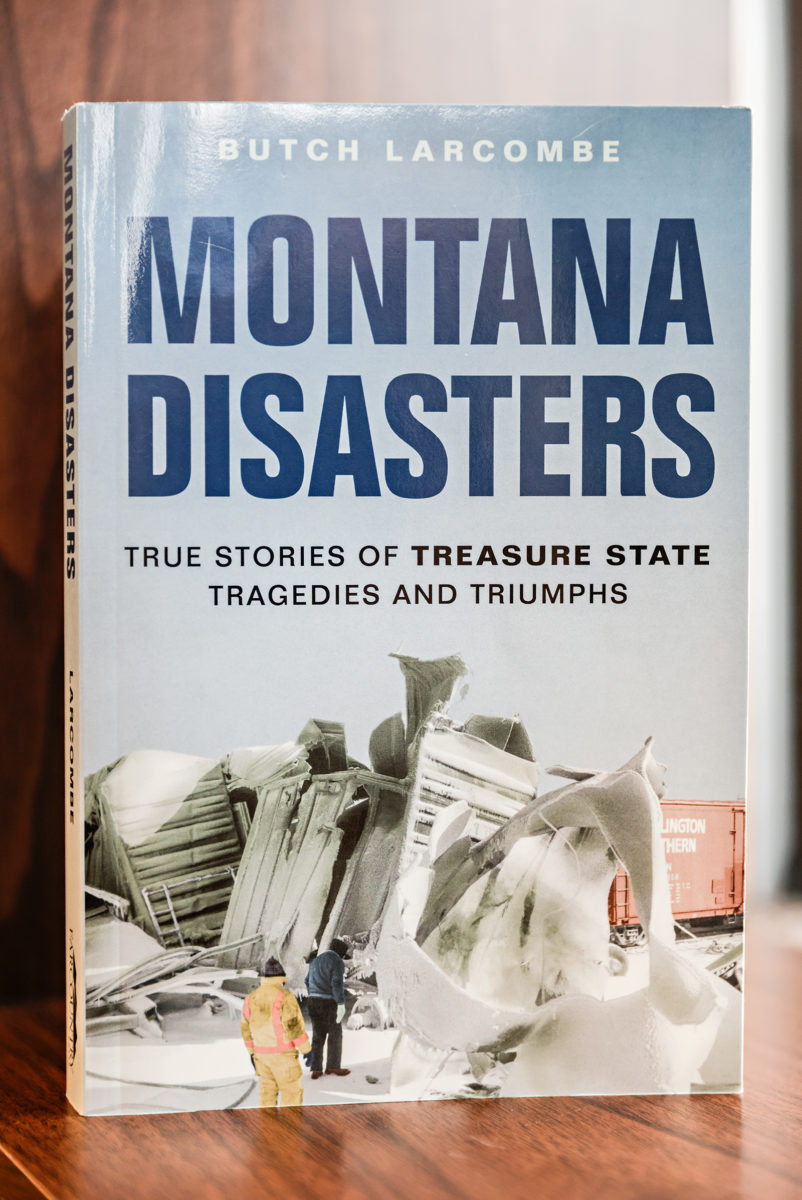The 10 chapters in Butch Larcombe’s new book “Montana Disasters: True Stories of Treasure State Tragedies and Triumphs” each focus on a different topic: train wrecks, wildfires, explosions and fires, mine disasters, dam failures, floods, avalanches, earthquakes, diseases and airplane crashes.
The disasters span the state, and include some — like the 1950 Eureka hotel fire, the floods of 1964, the 1902 Nyack train wreck, and the Mount Cleveland climbing disaster of 1969 — that Larcombe believes may be of extra significance to Flathead Valley residents.
Larcombe is firm on the point that the 264-page book isn’t meant to be a ranked list. The book also isn’t meant to be comprehensive. Part of that decision-making process for including one disaster over another involved considering what would be of more interest to Montana readers.
“In writing about the Mann Gulch fire, author Norman Maclean noted his desire to build ‘a monument of knowledge’ to those who died on that steep, smokey slope above the Missouri River in 1949,” Larcombe writes in the introduction. “The stories on these pages may not be monumental, but I hope they can serve at least as cairns that mark a path to remembering.”
Speaking last week from his residence near Bigfork, Larcombe elaborated on some of the value he sees in remembering the state’s disasters.
“I would say, and I would tell this to anybody, it reminds me, personally, and a lot of other people, we lead pretty fortunate lives. Most of us haven’t been exposed to these sorts of situations. I think that’s good to remember, but also it’s a reminder in my eyes of the value of knowing about our shared past and trying to learn from it, whether it’s the flu epidemic, whether it’s mine safety,” Larcombe said. “There are good lessons from history, and sometimes I don’t think we’re really good about remembering those.”

Some of the disasters are well-known, while others Larcombe believes are more obscure, making the book to some degree an effort to prevent events from slipping through the cracks of collective memory.
One of the smaller scale disasters that resonated with Larcombe was the 1950 Montana Hotel fire in Eureka, which killed two members of the Browning boys basketball team and three other people.
“It just spoke to me about growing up in a small town,” he said, adding that it stirred memories of traveling for school trips and activities. “I guess in a sense I can put myself in their shoes and how frightening it would be.”
“Montana Disasters” was built in part upon previous work Larcombe had done as a newspaper reporter and freelance writer. Before taking a communications job with NorthWestern Energy that ended with his retirement in 2019, Larcombe had spent years working as a reporter and editor for publications in the state including the Great Falls Tribune, the Helena Independent Record and Montana Magazine. His newspaper roots go back even further. For almost 50 years Larcombe’s family operated the Phillips County News.
The researching and writing of “Montana Disasters” as a comprehensive book began in 2019, and the book was finally handed over to Helena-based publisher Farcountry Press in October of 2020, but Larcombe’s curiosity about the topic stretches back decades.
The author grew up in Malta on Montana’s Hi-Line, and recalled a 1964 family trip to the Flathead Valley to see his grandparents. Around Browning and East Glacier, the family encountered washed out roads, temporary bridges, and mud “everywhere.”
Larcombe learned some information from his mother, but in a carful of kids, he said “it wasn’t really the venue for an extended conversation.”
A few years later at age 10, Larcombe saw a framed photo in his father’s office of a man he didn’t recognize standing at a podium. Larcombe was told it was former Montana Gov. Donald Nutter, who died in a plane crash, but learned little else.
Those two small discoveries stuck with him and fed his curiosity over the years.
Reading “Montana Disasters” might be a grim proposition for some, but Larcombe said that in some of his interviews, and in some reactions to the book, he has found appreciation from some people for whom the disasters in question remain deeply personal.
And of course when Larcombe’s book hit shelves last month, Montanans had been living amid a pandemic disaster for going on two years. As of Monday, COVID-19 had caused the deaths of 2,908 Montanans, and hospitalized 10,433 people in the state.
COVID-19 is mentioned in the book in the context of the Rocky Mountain Laboratory, a biomedical research facility in Hamilton. COVID-19 goes without mention in the section about the influenza epidemic of 1918, but there are parallels, according to Larcombe.
“One, it kind of came in waves, like we’re getting with the various variants,” Larcombe said. “And then there was this sort of complacency with the whole thing, especially in the early part of the flu pandemic…that it was not a big deal, we didn’t really have to worry about it.”
Using newspaper archives, Larcombe recounts devastating tales of families decimated by the deadly disease. The one that sticks with him most, he said, is an account from the Billings Gazette set in the small eastern Montana town of Ismay.
“A local man decided to check on neighbors who had not been seen for days. Entering the home, he found a man, his wife, and two children dead in their beds, another child barely alive on the floor. Officials speculated that no one in the family had been well enough to care for the others. Along with the flu, officials suspected an additional factor in their deaths—starvation.”
